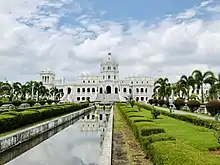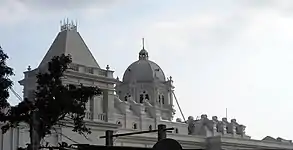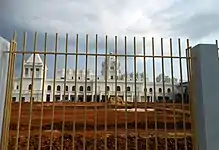Ujjayanta Palace
The Ujjayanta Palace (Nuyungma in Kokborok language) is a museum and the former palace of the Kingdom of Tripura situated in Agartala, which is now the capital of the Indian state of Tripura. The palace was constructed between 1899 and 1901 by Maharaja Radha Kishore Manikya Debbarma and stands on the banks of two lakes surrounded by gardens inspired by the European style. It was the home of the ruling Manikya dynasty until Tripura's merger into India in October 1949. The palace was purchased from the royal family by the Government of Tripura in 1972–73 for Rs. 2.5 million, and used to house the State Legislative Assembly until July 2011. Ujjayanta Palace is now a State Museum and it primarily showcases the lifestyle, arts, culture, tradition and utility crafts of communities residing in northeast India, along with a lot of stone sculptures, coinage of the Manikya dynasty and some other artefacts.
Nuyungma | |
 The Royal palace of Tripura | |

| |
| Established | 1901 |
|---|---|
| Location | Agartala, Tripura, India |
| Type | State Museum |
| Architect | Sir Alexander Martin (Martin and Burn Co.) |
| Kingdom of Tripura | |||||||||||||||||||||||||||||||||||||||||||||||||||||||||||||||||||||||||||||||||||||||||||||||||||||||
|---|---|---|---|---|---|---|---|---|---|---|---|---|---|---|---|---|---|---|---|---|---|---|---|---|---|---|---|---|---|---|---|---|---|---|---|---|---|---|---|---|---|---|---|---|---|---|---|---|---|---|---|---|---|---|---|---|---|---|---|---|---|---|---|---|---|---|---|---|---|---|---|---|---|---|---|---|---|---|---|---|---|---|---|---|---|---|---|---|---|---|---|---|---|---|---|---|---|---|---|---|---|---|---|
| Part of History of Tripura | |||||||||||||||||||||||||||||||||||||||||||||||||||||||||||||||||||||||||||||||||||||||||||||||||||||||
| |||||||||||||||||||||||||||||||||||||||||||||||||||||||||||||||||||||||||||||||||||||||||||||||||||||||
| Tripura monarchy data | |||||||||||||||||||||||||||||||||||||||||||||||||||||||||||||||||||||||||||||||||||||||||||||||||||||||
| Manikya dynasty (Royal family) | |||||||||||||||||||||||||||||||||||||||||||||||||||||||||||||||||||||||||||||||||||||||||||||||||||||||
| Agartala (Capital of the kingdom) | |||||||||||||||||||||||||||||||||||||||||||||||||||||||||||||||||||||||||||||||||||||||||||||||||||||||
| Ujjayanta Palace (Royal residence) | |||||||||||||||||||||||||||||||||||||||||||||||||||||||||||||||||||||||||||||||||||||||||||||||||||||||
| Neermahal (Royal residence) | |||||||||||||||||||||||||||||||||||||||||||||||||||||||||||||||||||||||||||||||||||||||||||||||||||||||
| Rajmala (Royal chronicle) | |||||||||||||||||||||||||||||||||||||||||||||||||||||||||||||||||||||||||||||||||||||||||||||||||||||||
| Tripura Buranji (Chronicle) | |||||||||||||||||||||||||||||||||||||||||||||||||||||||||||||||||||||||||||||||||||||||||||||||||||||||
| Chaturdasa Devata (Family deities) | |||||||||||||||||||||||||||||||||||||||||||||||||||||||||||||||||||||||||||||||||||||||||||||||||||||||
| Shamsher Gazi (Usurper) | |||||||||||||||||||||||||||||||||||||||||||||||||||||||||||||||||||||||||||||||||||||||||||||||||||||||
History
Tripura claims to be one of the oldest princely states of ancient India. The royal line of Tripura began during the reign of Maharaja Maha Manikya, who was crowned in 1400 AD, and was the first ruler under the royal title of Manikya. Ujjayanta Palace was built in 1862, 10 km (6 mi) away from Agartala, by King Ishan Chandra Manikya (1849–1862). It was devastated by the Assam earthquake of 12 June 1897.[1] The palace was rebuilt in the heart of Agartala city by Maharaja Radha Kishore Manikya in 1899–1901, at a then exorbitant cost of 10 lakh (1 million) rupees. It was built by Martin and Burn Co.,[2] and served as the model of the Maharajah's palace in Tintin and the Cigars of the Pharaoh.

As state assembly building
Upon the merger of the Kingdom of Tripura with India in 1949, royal properties were nationalised. The main building along with the area around the palace was purchased from the royal family by the Tripura government in 1972–73.[2] It housed the Tripura Legislative Assembly until July 2011 when the assembly moved to a new location 6 km (3.7 mi) north of Agartala.[3]
As state museum
The museum was given seismic retrofitting to prevent possible earthquake damage,[4] and the museum was inaugurated by the Vice-President of India Mohammad Hamid Ansari on 25 September 2013.[5]
Early in the museum's history, controversy erupted over the state government's proposed move to change the name of Ujjayanta Palace to Tripura State Museum. The Indigenous Nationalist Party of Twipra (INPT) has written to Vice-President, Hamid Ansari, protesting that the name of the museum should reflect the history and heritage of the region.[6][7] Pradyut Bikram Kishore Debbarma, the titular king of Tripura said, "The palace is a historical spot. It doesn’t belong to the members of the erstwhile royal family alone, neither does it solely belongs to the government. It belongs to Tripura and somebody in the government can’t suddenly impose a decision to change its name".[8] The government decided to keep the original name of Ujjayanta Palace and to build a statue of Maharaj Radha Kishore Manikya on the museum premises.[9]

Design
The Ujjayanta Palace compound covers an area of approximately 1 km2 (250 acres) and includes public rooms such as the throne room, durbar hall, library and reception hall.[10] The buildings and grounds cover 800 acres (3.2 km2) in the heart of Agartala. The neoclassical palace was designed by Sir Alexander Martin of the Martin and Burn Company. The two-storied palace has three large domes, the largest of which is 86 ft (26 m) high, and which rests atop a four-storied central tower. The architecture shows a mix of influences: Mughal, Roman and British[2] There are two large artificial ponds on either side of the garden which is decorated with pools and fountains.
Several Hindu temples occupy plots adjacent to Ujjayanta Palace, dedicated to Lakshmi Narayan, Uma-Maheshwari, Durga and Jagannath.[10]
Gallery
| Wikimedia Commons has media related to Ujjayanta Palace. |
 Ujjayanta Palace at night.
Ujjayanta Palace at night. A view from a different angle of the Ujjayanta Palace.
A view from a different angle of the Ujjayanta Palace. A part of the northern area of the Ujjayanta Palace.
A part of the northern area of the Ujjayanta Palace. The back lawn under construction at Ujjayanta Palace.
The back lawn under construction at Ujjayanta Palace.
References
- "Historic Earthquakes". Earthquake.usgs.gov. Retrieved 2 August 2016.
- Sujit Chakraborty (24 September 2013). "Tripura's royal mansion to house northeast's biggest museum". Newindianexpress.com. Retrieved 1 August 2016.
- "Tripura Assembly building inaugurated". Telegraphindia.com. 23 July 2011. Retrieved 2 August 2016.
- Supratim Bhowmik; et al. "Retrofitting of heritage building "Ujjayanta Palace" in Agartala – a case study". Academia.edu. Retrieved 2 August 2016.
- "Northeast India's biggest museum to open on Sep 25". Firstpost.com. 27 August 2013. Retrieved 2 August 2016.
- Sekhar Datta (20 September 2013). "History finds royal quarters". Telegraphindia.com. Retrieved 2 August 2016.
- Press Trust of India (17 September 2013). "Tribals protest renaming of Tripura palace". business-standard.com. Retrieved 1 August 2016.
- K Anurag (23 September 2013). "Tripura govt relents to mass protests against renaming of palace". Rediff.com. Retrieved 2 August 2016.
- "Tripura museum to retain name of Ujjayanta Palace". The Times of India. 24 September 2013. Retrieved 2 August 2016.
- "Ujjayanta Palace, Agartala". gobibo.com. Retrieved 2 August 2016.